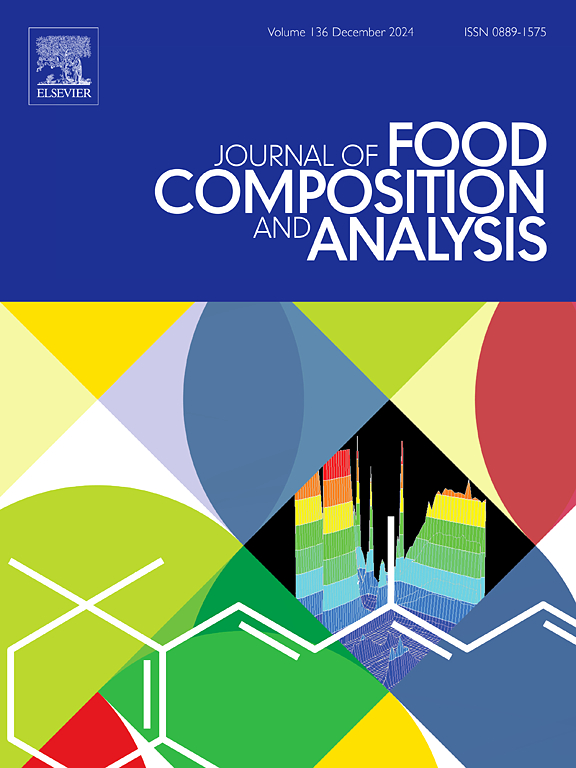Machine learning-based malachite green and leucomalachite green content in large-mouth bass prediction using Raman spectroscopy
IF 4
2区 农林科学
Q2 CHEMISTRY, APPLIED
引用次数: 0
Abstract
Carcinogenic malachite green (MG) and its metabolite leucomalachite green (LMG) in aquatic products present significant food safety risks. Conventional detection methods for MG and LMG, such as the liquid chromatography-tandem mass spectrometry (LC-MS/MS), are often time-consuming and destructive due to their laborious multi-step sample extraction and purification procedures, thereby hindering rapid screening in the aquaculture industry. This study addresses this need by developing a non-destructive method using Raman spectroscopy combined with machine learning to predict MG and LMG concentrations in large-mouth bass muscle tissue. Muscle samples were analyzed at multiple time points (0–480 min) post-MG/LMG exposure. Among evaluated preprocessing techniques (Savitzky-Golay smoothing, multiple scatter correction, standard normal variate, normalization), Savitzky-Golay smoothing proved most effective. Four machine learning regression models were tested: Partial Least-Squares Regression (PLSR), Random Forest Regression (RFR), XGBoost, and Back Propagation Neural Network (BPNN). RFR yielded the best predictions for MG (validation R² = 0.8090), while PLSR was optimal for LMG (validation R² = 0.8435). This Raman/ML approach enables rapid, non-invasive quantification of these banned residues, offering a practical tool for enhanced food safety monitoring in aquaculture.
基于机器学习的孔雀石绿和白孔雀石绿在拉曼光谱预测大口鲈鱼中的含量
水产品中的致癌物孔雀石绿(MG)及其代谢物白垩孔雀石绿(LMG)存在显著的食品安全风险。传统的MG和LMG检测方法,如液相色谱-串联质谱(LC-MS/MS),由于其费力的多步骤样品提取和纯化过程,往往是耗时和破坏性的,从而阻碍了水产养殖业的快速筛选。本研究通过开发一种使用拉曼光谱结合机器学习的非破坏性方法来预测大嘴鲈鱼肌肉组织中的MG和LMG浓度,从而解决了这一需求。肌肉样本在mg /LMG暴露后的多个时间点(0-480 min)进行分析。在评估的预处理技术(Savitzky-Golay平滑、多重散点校正、标准正态变量、归一化)中,Savitzky-Golay平滑被证明是最有效的。测试了四种机器学习回归模型:偏最小二乘回归(PLSR)、随机森林回归(RFR)、XGBoost和反向传播神经网络(BPNN)。RFR对MG的预测效果最佳(验证R²= 0.8090),PLSR对LMG的预测效果最佳(验证R²= 0.8435)。这种拉曼/ML方法能够快速,无创地定量这些禁用残留物,为加强水产养殖中的食品安全监测提供实用工具。
本文章由计算机程序翻译,如有差异,请以英文原文为准。
求助全文
约1分钟内获得全文
求助全文
来源期刊

Journal of Food Composition and Analysis
工程技术-食品科技
CiteScore
6.20
自引率
11.60%
发文量
601
审稿时长
53 days
期刊介绍:
The Journal of Food Composition and Analysis publishes manuscripts on scientific aspects of data on the chemical composition of human foods, with particular emphasis on actual data on composition of foods; analytical methods; studies on the manipulation, storage, distribution and use of food composition data; and studies on the statistics, use and distribution of such data and data systems. The Journal''s basis is nutrient composition, with increasing emphasis on bioactive non-nutrient and anti-nutrient components. Papers must provide sufficient description of the food samples, analytical methods, quality control procedures and statistical treatments of the data to permit the end users of the food composition data to evaluate the appropriateness of such data in their projects.
The Journal does not publish papers on: microbiological compounds; sensory quality; aromatics/volatiles in food and wine; essential oils; organoleptic characteristics of food; physical properties; or clinical papers and pharmacology-related papers.
 求助内容:
求助内容: 应助结果提醒方式:
应助结果提醒方式:


